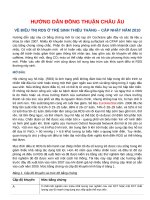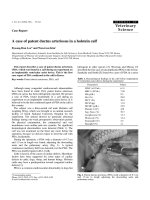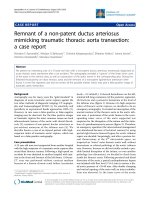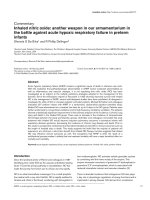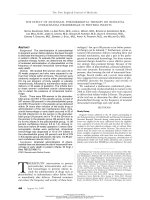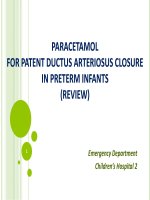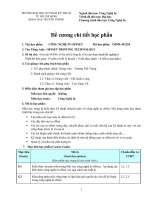PARACETAMOL FOR PATENT DUCTUS ARTERIOSUS CLOSURE IN PRETERM INFANTS , đại học
Bạn đang xem bản rút gọn của tài liệu. Xem và tải ngay bản đầy đủ của tài liệu tại đây (895.65 KB, 27 trang )
PARACETAMOL
FOR PATENT DUCTUS ARTERIOSUS CLOSURE
IN PRETERM INFANTS
(REVIEW)
1
Emergency Department
Children’s Hospital 2
2
OVERVIEW
Preterm
infants with moderate to large left-toright shunts:
Greater mortality rate
Increased risk of pulmonary edema, hemorrhage and
bronchopulmonary dysplasia
Decrease in perfusion and oxygen delivery to endorgans
3
MANAGEMENT OF PDA
Supportive
care
Fluid restriction 110 – 130 mL/kg
Permissive hypercapnia, low PaO2 targets, PEEP
Chlorothiazide is considered
Hct 35 - 40%
Neutral thermal environment
Cyclooxygenase
inhibitors: indomethacin &
ibuprofen (Grade 2B)
Surgical ligation
UpToDate
4
CONTRAINDICATIONS OF
INDOMETHACIN
Proven
or suspected infection untreated
Active bleeding
Thrombocytopenia, coagulation defects
Necrotizing enterocolitis
Significant impairment of renal function
Congenital heart disease in which patency
of the ductus arteriosus is necessary
5
IBUPROFEN
Good
points
As effective as
indomethacin in closing
PDA
Associated with a lower
risk of NEC, transient
renal insufficiency
Economic preference
Not-good
points
Contraindications for
ibuprofen are similar to
those for indomethacin
(except for NEC & RF)
Average peak bilirubin
levels were higher
6
PARACETAMOL
PARACETAMOL
A analgesic, antipyretic drug, weak antiinflammatory
Used in all age groups
In high concentrations inhibits the synthesis of
prostaglandins
7
Paracetamol vesus Ibuprofen
for patent ductus arterious
closure in preterm infants?
8
PARACETAMOL
FOR PATENT DUCTUS ARTERIOSUS
IN PRETERM INFANTS
9
METHODS
Size
2 RCTs: Dang 2013, Oncel 2013
n = 250
Three others is ongoing
Types
of participants
Infants born preterm (< 37 weeks PMA) or
with low birth weight (< 2500 g)
Echocardiographic diagnosis of a PDA
10
METHODS
Types
of interventions
The paracetamol group: 15 mg/kg orally
every 6 hours for 3 days
The ibuprofen group: initial dose of 10 mg/kg
orally followed by 5 mg/kg after 24 and 48
hours
11
PRIMARY OUTCOME
Failure
of PDA closure after the first course of
paracetamol treatment
12
PRIMARY OUTCOME
Both
studies (n = 250 infants) reported on
this outcome
There was no significant difference
between the paracetamol and the
ibuprofen groups in failure of PDA closure
(typical RR 0.90, 95% CI 0.67 to 1.22;
typical RD -0.04, 95% CI -0.16 to 0.08; I2 =
0% for RR and I2 = 23% for RD)
13
SECONDARY OUTCOMES
There
was no significant difference between
the paracetamol and the ibuprofen groups in
All-cause mortality during initial hospital stay
Neonatal mortality (death during the first 28
days of life)
Infant mortality (death during the first year of
life)
14
SECONDARY OUTCOMES
There
was no significant difference between
the paracetamol and the ibuprofen groups in:
Re-opening of the ductus arteriosus
Surgical closure of the PDA following treatment
failure
15
SECONDARY OUTCOMES
Re-opening
of the ductus arteriosus
16
SECONDARY OUTCOMES
There
was no significant difference between
the paracetamol and the ibuprofen groups in:
Duration of ventilator support (days)
Duration of hospitalisation (total length of
hospitalisation from birth to discharge home or
death, in days)
17
SECONDARY OUTCOMES
There
was no significant difference between
the paracetamol and the ibuprofen groups in:
Pulmonary hypertension
Bronchopulmonary dysplasia (BPD) at 28 days &
at 36 weeks PMA
Moderate to severe BPD according to the new
criteria
Severe BPD defined according to the new criteria
18
SECONDARY OUTCOMES
There
was no significant difference between
the paracetamol and the ibuprofen groups in:
Pulmonary haemorrhage (blood stained liquid
flowing from the trachea of the infant)
Intraventricular haemorrhage
Severe IVH (Grade III-IV)
Gastrointestinal bleed
19
SECONDARY OUTCOMES
There
was no significant difference between
the paracetamol and the ibuprofen groups in:
Periventricular leukomalacia
Necrotizing enterocolitis (NEC) (any stage)
Intestinal perforation (do not occur)
Retinopathy of prematurity (ROP) any stage
ROP stage ≥ 3
ROP requiring laser therapy
20
SECONDARY OUTCOMES
There
was no significant difference between
the paracetamol and the ibuprofen groups in:
Sepsis
Oliguria
Serum or plasma levels of creatinine, AST/ALT,
bilirubin after treatment
Liver failure did not occur
21
SECONDARY OUTCOMES
Duration
of need for supplementary
oxygen (days)
22
SECONDARY OUTCOMES
One
study (n = 90) reported on this
outcome
There was a significant difference
between the paracetamol and the
ibuprofen groups in the duration of need
of supplementary oxygen, favouring the
paracetamol treated group (MD -12.40
days, 95% CI -22.97 to -1.83)
23
SECONDARY OUTCOMES
Hyperbilirubinaemia
24
SECONDARY OUTCOMES
One
study reported on this outcome
(n=160)
There was a significant difference in
hyperbilirubinaemia favouring the
paracetamol groups (RR 0.57, 95% CI 0.34
to 0.97; RD -0.15, -0.29 to -0.01; NNTB 7,
95% CI 3 to 100)
25
